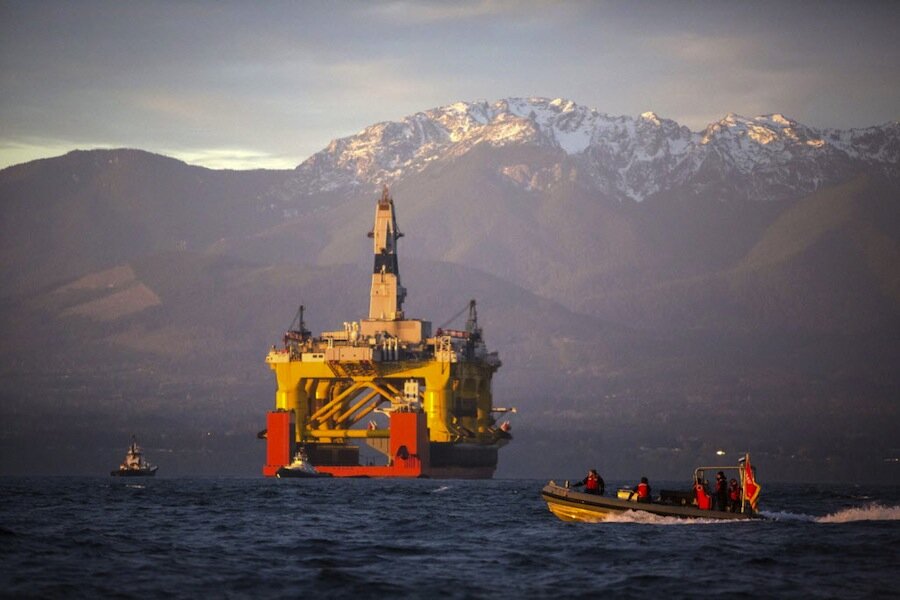Shell starts drilling for oil in the Arctic this month
It’s been a lot of work, but Royal Dutch Shell managed to overcome virtually all the obstacles thrown in its path as it moves towards exploratory drilling for oil and gas in the Arctic. Now the energy company is on track to begin work by the end of July.
A fleet of 30 vessels has left Dutch Harbor on Unalaska Island in the Aleutian chain, heading for the Chuckchi Sea north of the Bering Strait, where Shell plans to drill two wells as soon as the winter ice gives way to unencumbered summer waters.
But getting to this point has been a hard trek, and Shell has had to accept some of the blame for the trouble. Shell had a similar plan in 2012 but was unprepared for the harsh weather and had to rescue 18 workers and tow two of its rigs to safety. The U.S. Interior Department said Shell improperly supervised its contractors and refused to let work resume until the problems had been fixed. (Related: New Silk Road A Disaster Waiting To Happen?)
Since then, the Anglo-Dutch energy giant is spending an estimated $7 billion to make sure such an embarrassment doesn’t recur, but also to ensure that its drilling procedures are more efficient and that its environmental footprint in the Arctic is as small as possible.
Ann Pickard, Shell’s executive vice president for Arctic and Alaska, said recently in Norway that the company has learned from its previous mistakes in the Arctic. She ticked off the problems, including “delays with an oil-containment system, issues with one drilling rig and the grounding of another.”
“We’ve learned valuable lessons, listened to recommendations and have adapted our approach accordingly,” Pickard said.
The first order of business will be to begin drilling no more than two wells, a process that could take two years because such work must be limited to the summer months when the winter ice has melted. This year’s drilling will have to stop in late September, then resume in the summer of 2016, when Pickard says it hopes to drill four more wells. (Related: Chris Faulkner: A Real Look At The Oil Industry’s Self-Proclaimed Frack Master)
By then, perhaps, Shell will be able to focus solely on drilling, but only if it secures all the remaining permits it needs from the Interior Department. On May 11 the agency gave the company initial approval for the project, but it still must approve several more permits before drilling can begin.
And then there are the protests from environmentalists, who say drilling for energy in the Chuchki Sea could upset the delicate balance of wildlife habitat. One such demonstration was the May 16 “Paddle in Seattle,” in which protesters in small craft, including many kayaks, crowded the city’s Elliott Bay, not far from where Shell’s drilling rig Polar Pioneer was briefly docked during its trip to the Arctic. That protest didn’t change Shell’s mind, however. (Related: Bearish News For Oil Growing By The Day)
Four days later, CEO Ben van Beurden acknowledged the problems that fossil fuels pose to the environment, but said it would be unrealistic in today’s energy environment for his company not to search for more oil and gas wherever it can be found.
In a speech at Shell’s annual shareholder meeting in The Hague, Netherlands, on May 20, van Beurden scorned environmentalists’ demand for divestment in fossil fuel companies, saying no alternatives are ready yet.
“That particular theory also ignores the reality of the industry,” van Beurden said, arguing that an end to further investment in his industry would lead to a 70 million barrel-a-day fuel shortfall in 25 years. “We will need sustained and substantial investment to just meet the demand to fuel economic growth,” he said, “especially, of course, in the developing world.”
By Andy Tully Of Oilprice.com
More Top Reads From Oilprice.com:
- Exposing The Hypocrisy Of Wall Street
- Lessons From The Failed Rare Earth Investment Hype
- Greece And Iran Provide One-Two Punch To Oil Prices
Original story: http://oilprice.com/Latest-Energy-News/World-News/Shell-To-Start-Arctic-Drilling-End-Of-July.html
Source: http://oilprice.com/






